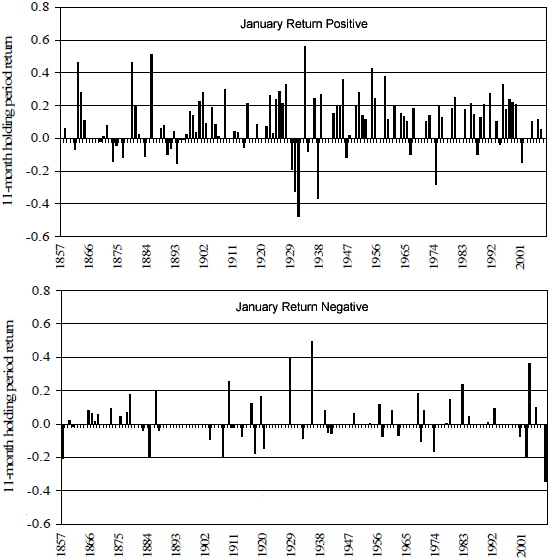The January Barometer (as goes January, so goes the rest of the year) seems persistent for U.S. stocks. Is there a best way to exploit it? In their July 2009 paper entitled “What’s the Best Way to Trade Using the January Barometer?”, Michael Cooper, John McConnell and Alexei Ovtchinnikov update their prior analysis of the January Barometer through 2008 and explore how an investor can best exploit its signal. Specifically, they consider five alternative strategies (all ignoring trading costs and taxes): (1) long stocks all the time; (2) long stocks in all Januaries and long (short) stocks during February-December when the return for January is positive (negative); (3) long stocks in all Januaries and long stocks (Treasury bills) during February-December when the return for January is positive (negative); (4) long Treasury bills all the time; and, (5) long stocks in all Januarys and long Treasury bills the rest of all years. Using monthly U.S. stock returns and one-month Treasury bill (or equivalent) yields over the period 1857-2008 (152 years), they conclude that:
- Over the entire sample period, 100 (52) Januarys have positive (negative) stock market returns, with an average February-December return of 11.0% (2.84%). This predictive power is evident also during 1857-1939 and 1940-2008 subperiods. (See the charts below.)
- The January Barometer failed to guide investors out of stocks during two of the three worst February-December intervals (1931 and 1937), but it did work for one of the three (2008).
- Over the last five years, the average February-December stock market return has been 8.75% when January is an up month (2004, 2006 and 2007) and -13.63% when January is a down month (2005 and 2008).
- The best way to exploit the January Barometer is not to be long stocks after positive Januarys and short stocks after negative Januarys, but rather to be long stocks after positive Januarys and long Treasury bills after negative Januarys.
- Over the entire 1857-2008 sample period, starting with a $1.00 initial investment in January 1857, terminal value is $170,807 for buying and holding stocks and $562,773 for being long stocks in Januaries and long stocks (Treasury bills) when the January return is positive (negative). The terminal values for the other three strategies tested are relatively very small. The stocks/Treasury bills strategy also produces the highest Sharpe ratio of 0.38, compared to 0.31 for buying and holding stocks.
- For the 1940-2008 subperiod, a $1.00 initial investment grows to a terminal value of $942 for a buying and holding stocks, compared to $2,182 for the stocks/Treasury bills strategy. A long/short stocks strategy comes in a distant third at $389.
The following charts, taken from the paper, present the February-December stock market returns for each year during 1857-2008 when the January return is positive (top chart) and negative (bottom chart). 100 (52) Januaries are positive (negative), with an average market return of 11.0% (2.84%) during the ensuing February-December interval. The spread of 8.17% is both economically and statistically significant.

In summary, an up (down) January historically indicates February-December outperformance (underperformance) for the broad U.S. stock market, an anomaly best exploited by a strategy of being in stocks (Treasury bills) when January is up (down).